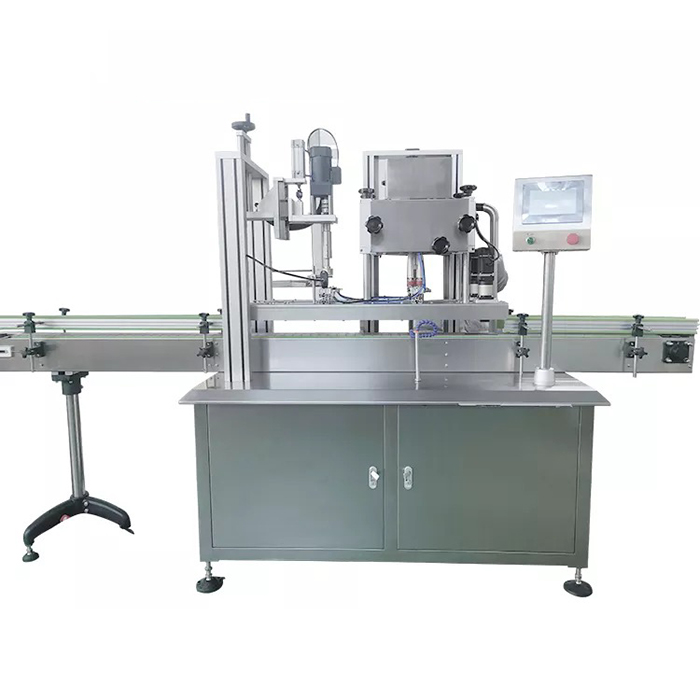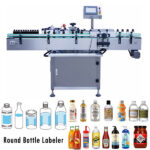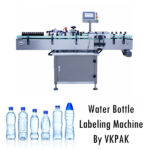A bottle cap machine is a machine that tightens or secures a container’s cap. Every company that fills products into bottles, containers, or jars needs a way to close the container, and the most common closure is a cap. According to the capping method, Bottle capping machines basically come in three categories: chuck cappers, spindle cappers, and snap Cappers. According to operation mode, Bottle capping machines basically come in two categories: inline cappers and rotary chuck-style cappers. These two machines differ from each other in their core designs, as well as in the techniques they apply for closures, such as torque control and the use of a magnetic brake.
Inline capping machines have side gripping belts that grip the outer edges of the bottles that travel along the conveyor. The gripping belts are speed-matched to the conveyor so that no bottle escapes. As the bottle passes under the cap dispenser, a cap is stripped out by its neck finish. Then, a series of cap tightening wheels spin the cap onto the threaded neck finish as the closure resting on the finish passes through them. Finally, a pair of wheels equipped with friction clutches delivers the desired torque to the capped bottle. The bottle, now tightly capped, is released from the gripping belts.
One of our best sellers is our linear automatic spindle screw capping machine. This capping machine can handle a wide range of caps and containers without change parts and is more forgiving and easier to set up than most bottle capping equipment in the industry.
When choosing a bottle capping machine you need to take into consideration many factors like capping speed, bottle material, and shape, compatibility between bottle and caps.
On plastic bottle cappers, it’s very important to take into consideration deformation that may happen when the capper is holding the bottles to prevent rotation when applying the required torque. There are many solutions for this type of bottle capping problems and it will depend on the shape, rigidity, holding spots among others.
VKPAK Inline Capping Equipment Videos
VKPAK Bottle Capping Equipment
VKPAK designs, manufactures and supports linear spindle capping and retorquing systems for screw-on closures and inline capping systems for snap-on caps. Our systems accommodate a wide range of container sizes, shapes and types as well as a wide range of cap types and styles. They are widely used in the personal care, household cleaning, laundry, automotive, food and industrial chemical product categories.
Every VKPAK inline capping system is designed and configured for each customer’s specific application, requirements, line layout and site constraints. When supplied as integrated capping systems, VKPAK components offer unmatched performance because they are designed and configured to work seamlessly together to deliver the required results.
What’s better, an Inline Capper or a Rotary Chuck Bottle Capper
Each project is different so it’s not that easy to respond, in general:
Inline bottle cappers are better when:
- A wide range of containers/caps are used
- Speeds less than 150 bottle capping per minute
- Small and medium production runs
- When flexibility in bottle cappers capping machines is important, new projects on chuck cappers require change parts, capping heads, infeed screws and is not only expensive but it takes a lot of time to manufacture this part
- Limited budget since linear cappers are less expensive
Rotary chuck bottle capper are better when:
- When cap design cannot be picked up by the bottle (Like a laundry cap with dispensing)
- A limited type of bottles and same caps are used
- Speeds of more than 150 bottle capping per minute
- Large production runs
- Better torque control and/or cap placement is required
- A larger budget is possible
Why should we buy the inline capping machines from VKPAK?
Here are the top 12 reasons:
- We offer the best value for your money, our capping machines are better built, designed and can achieve competitive prices because of our volumes as well as owning our own machine shop.
- Our extensive, heavy duty use of stainless steel will guarantee that you will have a machine operational for many years
- Easy bottle belt adjustable in, out, up, and down with handles
- A proven design by constantly improving and debugging even small problems and functionality of our machines.
- We offer different cap feeding systems to accommodate a wide range of bottles and caps.
- Many options to accommodate every project like reverse spindle, power height, double belt
- We adopt the mode of ‘one motor controls one capping wheel’, which can ensure the machine to work stably and keep consistent torque under long term working condition.
- The clamping belts can be adjusted separately, which allow the machine to be suitable for capping bottles with various heights and shapes.
- If you choose the optional cap guiding system together with the machine, it will then also fit for pump caps.
- The convenient construction adjustment system is equipped with precise ruler and counter.
- The mainframe can be lifted and descended automatically by a motor.
- We have change the bottoms operation to touch screen operation.
Should I buy an automatic linear bottle capping machine with automatic cap feeding?
Setting up automatic capping machines without cap feeding (Tightener) is very easy and it only takes a few minutes but it requires manual labor so if it’s a small production run of a few hundred or a couple of thousand bottles it may be more efficient to just place those caps by hand.
If production runs are longer you will find that taking the time to set up your capper and investing on a good bottle capper machine with cap feeding will pay for itself very quickly.
What type of cap feeder should I choose:
There are many factors to take into consideration to choose the right cap feeder, here are the most important:
- How many different cap capper sizes and designs you intend to run
- Required cap capping feeding speed
- Space constraints
- Changeover time
- Cost
Depending on these and other factors the best feeder may be:
- Waterfall cap feeder (great for large flat caps)
- Vibratory cap feeder










